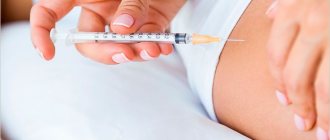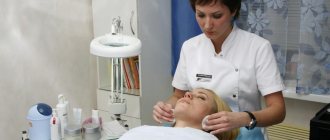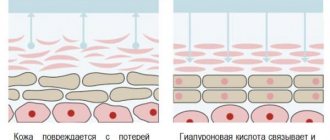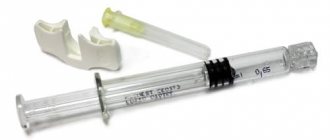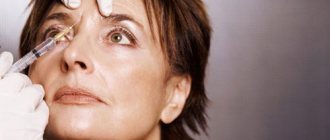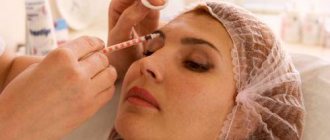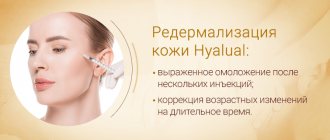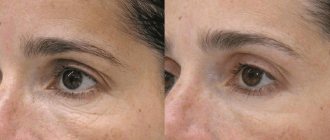POLYNUCLEOTIDES - a sensation in injection anti-aging programs from PMGroups One of the innovative promising areas of aesthetic cosmetology is methods of rejuvenation of soft tissues of the face and body using drugs based on polynucleotides (more precisely, polydeoxyribonucleotides or PDRN ) - biopolymers consisting of fragments of low molecular weight DNA and having the ability to trigger processes regeneration and cell division. PMGroups offers the restoration of youthful skin of the face and body with the help of highly effective injection preparations of the new generation TM PHILOSOPHY®, created on the basis of PDRN - Polyderm and Polyderm N II What are polynucleotides? By their structure, polynucleotides or PDRN are elements of low molecular weight DNA that do not cause genetic transformation and are completely safe for humans. They are a building biomaterial that restores the intercellular space of our skin from the inside.
What does PDRN apply to?
| High concentration of active ingredient (AI) and high viscosity | Powerful and long-lasting effect on skin cells, which eliminates the appearance of age-related changes |
| Long polymer chains (PN) | The ability to bind water molecules, which has a pronounced moisturizing effect |
| Stimulation of skin cell receptors (fibroblasts) | Increased proliferative and metabolic activity, resulting in active tissue regeneration |
| Prolonged action of the active components of the drug | The production of growth factors increases, collagen synthesis is normalized, DNA synthesis is activated |
Bio-reinforcement of the face with hyaluronic acid
Hyaluronic acid is the main component of bioreinforcement preparations. This technique restores the connective tissue framework of the dermis by reinforcing the skin with materials that are biologically compatible with the skin. Gel fillers for bio-reinforcement of the face with hyaluronic acid, unlike biorevitalizants for hydration, have a denser and more viscous structure, which allows the formation of a strong mesh of thin gel-like threads. To achieve a similar effect, filler is injected using a fan or tunnel technique.
Main indications:
- ptosis of the corners of the mouth, eyes, eyebrows;
- stretching and sagging skin on the face and body;
- severity of nasolabial folds;
- changes in the contours of the chin and lower jaw.
The physiological effect of bioreinforcement is to tension the tissue around the wound surface and reduce skin volume. From about 14 weeks, a connective tissue framework of its own forms around the tunnel with gel filler, restraining ptosis. Gradually released hyaluronic acid has a local stimulating effect similar to biorevitalization.
Bioreinforcement has proven itself well on the face and body. Maximum effectiveness is observed in women aged 35 to 50 years.
Biorevitalization and bioreinforcement of the periorbital area
The condition of the area around the eyes is considered the main marker of the severity of age-related changes. In clients with active facial expressions, deep creases in the preorbital region are noted as early as 25 years of age.
Specific side effects from hyaluronic acid injections in the periorbital area include:
- increased swelling around the eyes and patients with a tendency to accumulate water in tissues during biorevitalization;
- disruption of lymph flow due to incorrect placement of filler gel in the case of bioreinforcement and non-surgical blepharoplasty.
A significant role in eliminating these risks is played by the choice of drugs with high plasticity. And for people with a high probability of swelling, it would be advisable to use polynucleotide preparations for the area around the eyes.
Expected effect
- rejuvenating effect due to stimulation of fibroblasts, synthesis of nucleic acids
- moisturizing effect due to increased production of HA
- elasticity and firmness due to stimulation of collagen and elastin production
- antioxidant effect due to adsorption and neutralization of free radicals
- restorative effect due to activation of receptors that are responsible for the formation of new blood vessels
- reduction of pigmentation due to decreased melanin synthesis in melanocytes
Advantages of PDRN over other rejuvenation methods
Previously, the anti-aging section of cosmetology fought against age-related changes by introducing a kind of implants under the skin. Silicone largely played this role. Droplets of silicone were injected under the skin, leveled, and thus the skin in the area of wrinkles was raised and creases became less obvious.
PDRN in cosmetology is a completely different approach in the fight against wrinkles, pigmentation and other skin problems. The method of introducing polynucleotides is aimed at combating the cause of epidermal defects.
Injections of the substance are aimed at stimulating suspended metabolism in cells. Hyaluronic acid plays the same role. It also stimulates metabolic processes in the body that are responsible for cell regeneration, but with a less pronounced effect.
Thus, injections of polynucleotides in combination with biorevitalization, peeling and other cleansing and corrective procedures can resume natural cell renewal, as well as help the system get rid of old, accumulating and defective DNA molecules.
Modern drugs based on PDNR
PLINEST (Mastelli, Italy) 2 mlContains 20 mg/ml hyaluronic acid and 40 mg polynucleotides. Designed to restore and lift aging skin. Average course: 3 procedures with an interval of 2 weeks, 2-3 times a year. |
PLINEST FAST (Mastelli, Italy) 2 mlContains 7.5 mg/ml hyaluronic acid and 15 mg polynucleotides. Designed to restore and moisturize thin skin with fine-wrinkled aging, as well as delicate areas and the eye area. Ideal for young skin and scalp. Average course: 3 procedures with an interval of 2 weeks, 2-3 times a year. |
TWAC EYES (Yuma Medical LP, United Kingdom) 1 mlContains 2 mg of polynucleotides. Recommended for use in delicate areas (periorbital, perioral, neck, décolleté), as well as for preparing the skin before and after traumatic procedures as a reparative agent. Average course: 4 procedures with an interval of 10 days, 2-3 times a year. |
TWAC 2.0 (Yuma Medical LP, United Kingdom) 3 mlContains 15 mg/ml hyaluronic acid and 5 mg polynucleotides. Designed to restore and moisturize thin skin with finely wrinkled type of aging, as well as to prevent photoaging. Average course: 4 procedures with an interval of 3 weeks. |
TWAC 3.0 (Yuma Medical LP, United Kingdom) 3 mlContains 20 mg/ml hyaluronic acid and 10 mg polynucleotides. Designed for restoration and lifting of all skin types as an armirant. Average course: 4 procedures with an interval of 3 weeks. |
D-NUCLEO UNO (Israel) 1 mlBiostimulators based on PDRN and two types of hyaluronic acid. PDRN 2 mg/ml. Ideal for use in the periorbital area, it gives a pronounced anti-edematous effect. Effective in the treatment of scars, hyperpigmentation, and recovery after traumatic procedures. Average course: 4 procedures with an interval of 10 days. |
D-NUCLEO DUE (Israel) 2 mlContains 15 mg/ml native hyaluronic acid and 8 mg/ml stabilized hyaluronic acid and 5 mg polynucleotides. Designed to restore and deeply moisturize all skin types. Average course: 3-4 procedures with an interval of 3-4 weeks. |
Polynucleotides in cosmetology
A new direction in aesthetic cosmetology is the restoration of the intercellular space of the dermis with the help of polynucleotides, or nucleic acids. These complex proteins, formed from nucleic bases, come in two types:
- ribonucleic acid (RNA);
- deoxyribonucleic acid (DNA).
Nucleic acids are involved in all vital cellular processes, so the possibility of their use as medicines has been studied for many years. Some time ago, the high ability of exogenous polynucleotide complexes to penetrate into cells and activate metabolic and restoration processes in them was proven. Thanks to this discovery, the arsenal of aesthetic cosmetology was replenished with drugs for deep skin restoration based on polynucleotides.
Healing period
Despite the fact that the cosmetic procedure is not a surgical operation, it necessarily includes a recovery period. The face looks swollen, there is pain, sensitivity, and redness. During this period, it is important to follow medical recommendations to prevent side effects and speed up healing.
Recovery rules:
- During the day, limit touching the skin, use gentle foam for washing;
- for the first 48 hours, apply anti-inflammatory agents recommended by your doctor;
- During the week you cannot visit the sauna, solarium, swimming pool, avoid alcohol, reduce salt intake;
- Physiotherapeutic and cosmetic procedures are not recommended;
- about 2 weeks you should not carry out implantation, surgery, chemical peeling;
- It is important to protect the skin from exposure to ultraviolet radiation and use special products.
The result lasts from several months to a year. The rate of elimination of the drug depends on the composition, individual characteristics, and lifestyle of the patient.
Contraindications
From the legal side, PDRN rejuvenation cannot be done to persons under 18 years of age (only with written parental consent), pregnant and nursing mothers. The point is not that the drug can harm their health, since no one has tested this category of people, so the result of the effect of polynucleotides on their body cannot be predicted.
The following contraindications are related to the procedure itself, in which damage to the skin and blood vessels occurs using a needle. The rejuvenation course cannot be carried out for people who take anticoagulants that reduce the concentration of platelets in the blood, as well as antibiotics. Those suffering from congenital or acquired immunodeficiency also fall into the group of contraindications.
If a person has begun a period of exacerbation of skin diseases, such as dermatitis, eczema and other inflammatory processes, he should wait for remission, and only then sign up for a correction course at the clinic.
Other contraindications include the following diseases:
- diabetes;
- autoimmune diseases;
- neoplasms and cancer.
Also, if the client’s body is susceptible to various allergic reactions, he is at risk. It is not recommended to carry out injections if there are small wounds, cuts, or scratches in the affected area.
According to experts, if a patient has keloid scars on their body, that is, their body tends to scar wounds, there is a chance that the injection marks will not heal completely.
Patient reviews
On the Internet it is difficult to find reviews of real patients who used Beatrice drugs. But there are descriptions of the use of biorevitalizants similar in composition.
The review indicates the need to select a drug with a doctor, and not based on someone else’s experience.
The user describes the healing period and asks how long it will last.
The participant is interested in the specifics of the technique.
Other reviews can be found on the forum
Advantages and disadvantages
The drug is quite new, so it is difficult to find a complete description. But compliance with European quality certificates and injections performed by a doctor ensures the achievement of the desired results. Before deciding to proceed, it is important to weigh the pros and cons.
Pros:
- a wide range allows you to choose an individual program;
- you can evaluate the effect immediately after the procedure, the effect will increase within 2 weeks;
- safety of the formula;
- used for different age groups;
- allows you to solve a whole range of aesthetic problems.
Minuses:
- new drugs do not have enough reviews of their use;
- Can only be carried out by a qualified specialist who has been trained in work techniques;
- high price.
Progress of the procedure
Rejuvenation with polynucleotides in injection cosmetology is similar to the injection of hyaluronic acid or botulinum toxin. Before the procedure, the patient must be examined in the clinic for the presence of contraindications. Then an area of influence is selected on the body, which the doctor treats with an alcohol solution.
In this case, anesthesia is not used; the needle is so thin that the patient practically does not feel pain. Depending on the area on the body, the specialist selects the appropriate acupuncture technique. Typically, preparations based on hyaluronic acid are administered using a fan technique, linear, mesh, pointwise, etc. That is, several injections are given in different places.
During the procedure, droplets of blood may appear on the skin, which the cosmetologist immediately wipes off with a cotton pad soaked in an alcohol solution. When the correction is completed, the doctor may perform a light facial massage so that the substance is evenly distributed under the skin. It is not recommended to do this yourself. On average, the entire procedure, including preparation, takes 1 hour.
